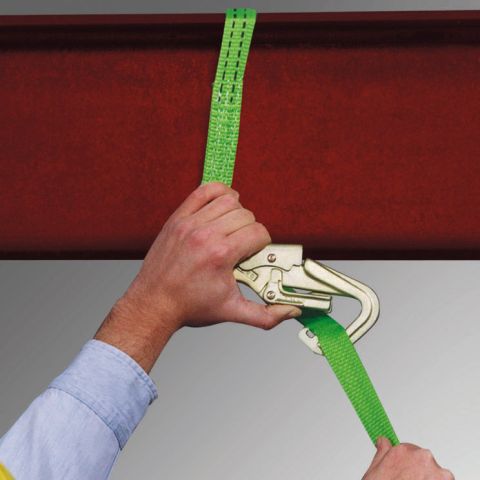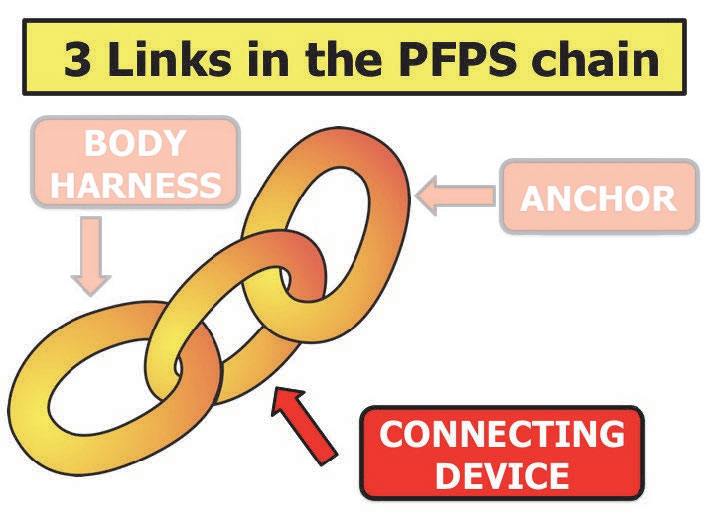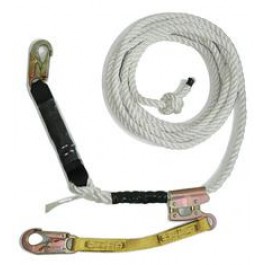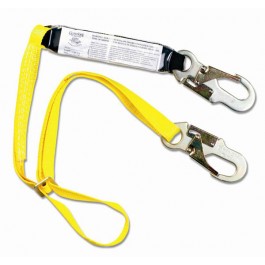3 Components of a Personal Fall Arrest System - Part 3: Connectors
This is the last and final article in a series that covers that basics of personal fall protection. First we took a look at anchor points, secondly we reviewed body harnesses, and now in this last article we look at the devices that connect the anchor and the harness.
Third Component of a Fall Arrest System: Connecting Device
Connecting devices come in four main forms: standard lanyards, shock-absorbing lanyards, self-retracting lifelines and rope grabs.
Standard Lanyards
Lanyards come in three main materials
|
Rope |
Cable |
Web |
Each type of lanyard has its own advantages and disadvantages. For example, rope is easily cut or abraded. Steel cable lanyards have no stretch and can conduct electricity, while web lanyards have less stretch than rope, but are more durable and easier to inspect. You'll have to understand each, in order to select the appropriate product.
Double Legged Lanyard

Double legged lanyards are available for 100% connection. For example, if you have to traverse around a column, keep one leg of the lanyard connected to one anchor and then attach the second leg to an additional anchor located past the column. Once attached to the second anchor, you can disconnect from the original anchor. This allows you to be fully connected at all times.
Always connect the center of the Y to the D Ring between your shoulder blades. When the second leg isn't connected to an anchor, never connect it to a strap on the harness. Always connect it to the approved attachment point on the harness.
Choking Your Lanyard

Using a traditional lanyard and connecting the snap hook back onto the lanyard itself is called “choking” the lanyard.
Either the gate on the snap hook can be overloaded, or since the lanyard strength can be reduced greatly when you
choke, the lanyard itself can fail.
There are lanyards available that do allow you to choke. The webbing strength has been greatly increased and the snap hook has been re-designed to withstand the forces generated in this type of fall. This type of lanyard now combines two links in our chain model; the A link (the lanyard acts as an anchorage connector) and the C link (the lanyard connects the harness to the anchor point). Make sure you read the product label to ensure that you have selected the appropriate product.
5,000 lb snap hook which allows the lanyard to be choked.
Shock-Absorbing Lanyards
Shock-absorbing lanyards come in two main styles
|
Pack or Pouch Style |
In-line Style |
In order to meet the ANSI standards and OSHA requirements, shock absorbers must have a maximum deceleration distance (shock absorber extension) of 3.5 feet.
Most shock absorbers will limit fall forces to 900lbs with a 6 foot free fall.
Double Packed Shock Absorbers
“Double packed” shock absorbers are available where 6 foot free falls, or the maximum working weight of 310lbs, are exceeded. You must read the label in order to ensure you have selected the proper shock absorber.
“Double packed” shock absorbers are used for either free falls greater than 6 feet, or for working weights greater than 310lbs, BUT NOT BOTH!!
Self-Retracting Lifelines
|
Web Retractable |
Cable Retractable |
Retractables are also called “fall limiters”. They are designed to be used with over head anchor points. The term “retractable” refers to the ability of the web or cable retracting back into the housing. Retractables activate when the line speed leaving the housing exceeds a pre-determined speed (e.g. 4.5 feet per second). Most units have shock absorbing capability, so fall forces don’t exceed the maximum forces permitted. In order to meet the ANSI requirements, retractables must activate and come to a complete stop within 4.5 feet. Many now accomplish this in a foot or less.
Retractables have two advantages; they provide a shorter fall clearance and maintain fall forces similar to a shock absorbing lanyard.
Retractables come in a variety of lengths ranging from 6 feet to 195 feet.
Never leave the cable or web extended during storage. A tag line should be connected to the snap hook with the line pulled out when the unit is to be used.
Rope Grabs

Manual grabs can be used on either vertical lines or sloped applications such as roofing. Watch for the “anti panic grab” or “death grip” feature on manual grabs. While moving the grab in its open position, if you were to fall, most people will keep holding the grab open and you would ride the grab down to the ground.
Trailing or automatic grabs are to be used on vertical lines only. Make sure you don’t use a lanyard that will allow you to exceed the maximum free fall allowable.
Grabs can be used on rope or cable (different products).
Important Points to Remember
Remember with any connecting devices we must keep in mind:
- The maximum free fall allowable in fall arrest is 6 feet
- The maximum deceleration distance allowable is 3.5 feet
- The maximum arrest force is 1800lbs
Most shock absorbers limit fall forces to 900lbs
If you haven't already, please take the time to review the other two articles in this series. Our hope is that in helping to review this vital safety information, you and the people you work with will go home safely at the end of every work day.












